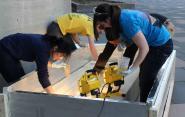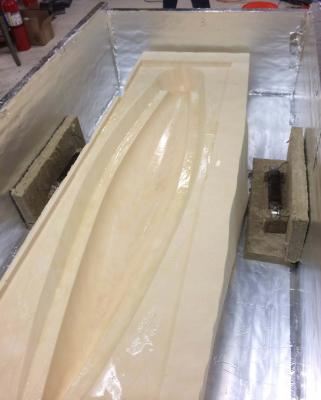Over Spring Break, Students Gear Up for New Challenges

In the Center for Engineering Innovation and Design (CEID), Alois Cerbu is insulating a heater that he'll soon connect to a very large, custom-built "oven." But instead of making baked goods, Carillo will be using this oven to bake a sailboat.

The oven is only one of the many projects Yale students completed over the 2015 Spring Break. From experiments in the wet lab to tweaking the components of a radio telescope, students utilized the break to push their independent research forward and make headway on projects that inspire them outside the classroom. "Students often use spring break to deeply engage with the project they most care about," said Vince Wilczynski, Deputy Dean of SEAS and the James S. Tyler Director of the CEID. "Whether that be classwork or extracurricular projects, spring brea is a rare opportunity for them to focus intensely on a single task over multiple days—a sustained focus that complements the breadth of their engineering education."
But even amid all the activity, It was impossible to miss two projects in particular. For Cerbu and his teammates on the Yale Intelligent Vehicles (InVe) team, spring break was a chance to do something big, literally. The team is preparing to compete in the 2016 International Sailing Regata, informally known as Sailbot. Between now and then, InVe will fabricate a 2-meter long autonomous robotic sailboat with custom electronics and software, with the goal of competing in five different challenges: a fleet race, a station keeping challenge, a navigation challenge, a long distance race, and an autonomous computer vision challenge.

The team used spring break to make significant headway on the construction of their carbon fiber hull, which required curing at high temperatures to rigidly set the epoxy. "The temperature has to be hot enough for everything to work right, but also not so hot that it becomes unsafe," said Cerbu, the InVe fabrication lead. "Spring break not only gave us the time and space to carve the mold out of our substrate but also ample time to discuss the details with the fire marshal and practice essential techniques for the curing process, such as vacuum bagging."
Meanwhile, on the other side of the CEID, a very different kind of vehicle was being put together. "Spring break was just what we needed to prepare for our upcoming launch test," said Lucia Korpas, the rocket competition project director for the Yale Undergraduate Aerospace Competition (YUAA). Korpas and her team—one of four current YUAA teams, all of whom made headway over spring break—used their time in the CEID to focus on their "Planetary Rover" rocket, which will be 11 feet tall and 7.5 inches in diameter. The rocket, carrying a rover payload, will launch to at least 1,000 feet on a K motor, then release a rover that, with its own recovery system, will land and perform a series of tasks on the ground.
But as the team prepares to compete in two events in the 2015 Battle of the Rocket Competition—held March 28th in Culpeper, Virginia—the pressure was on to get in one last test flight before classes continued. After wrapping up in the CEID, the team headed out on Sunday for one last launch to test the line cutting mechanism that will separate the competition rover from the parachute after its deployment from the rocket.
"Thanks to the dedication of the team, the rocket flew successfully," said Genivieve Fowler, YUAA president. "And now we're ready for one of the highlights of our year—our annual 'state-of-the-YUAA,' Aeronautica!" Fowler added that the event, which will offer highlights of the past year of YUAA successes, is open to the public and will take place at 5:00pm today, March 25th, in Sudler Hall.
And with that, just like other students across Yale, the rush of the semester begins again.

